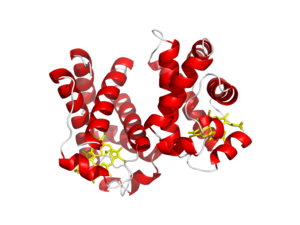
| Leghaemoglobin, iron-binding site | |
|---|---|
| Identifiers | |
| Symbol | Leghaemoglobin_Fe_BS |
| InterPro | IPR019824 |
| PROSITE | PS00208 |
Leghemoglobin (also leghaemoglobin or legoglobin) is an oxygen-carrying phytoglobin found in the nitrogen-fixing root nodules of leguminous plants. It is produced by these plants in response to the roots being colonized by nitrogen-fixing bacteria, termed rhizobia, as part of the symbiotic interaction between plant and bacterium: roots not colonized by Rhizobium do not synthesise leghemoglobin. Leghemoglobin has close chemical and structural similarities to hemoglobin, and, like hemoglobin, is red in colour. It was originally thought that the heme prosthetic group for plant leghemoglobin was provided by the bacterial symbiont within symbiotic root nodules.[1][2] However, subsequent work shows that the plant host strongly expresses heme biosynthesis genes within nodules, and that activation of those genes correlates with leghemoglobin gene expression in developing nodules.[3][4][5][6][7][8][9][10]
In plants colonised by Rhizobium, such as alfalfa or soybeans, the presence of oxygen in the root nodules would reduce the activity of the oxygen-sensitive nitrogenase, which is an enzyme responsible for the fixation of atmospheric nitrogen. Leghemoglobin is shown to buffer the concentration of free oxygen in the cytoplasm of infected plant cells to ensure the proper function of root nodules. That being said, nitrogen fixation is an extremely energetically costly process, so aerobic respiration, which necessitates high oxygen concentration, is necessary in the cells of the root nodule.[11] Leghemoglobin maintains a free oxygen concentration that is low enough to allow nitrogenase to function, but a high enough total oxygen concentration (free and bound to leghemoglobin) for aerobic respiration.
Leghemoglobin falls into the class of symbiotic globins, which also include the root nodules globins of actinorhizal plants such as Casuarina. The Casuarina symbiotic globin is intermediate between leghemoglobin and nonsymbiotic phytoglobin-2.[12][13]
- ^ Nadler KD, Avissar YJ (September 1977). "Heme Synthesis in Soybean Root Nodules: I. On the Role of Bacteroid delta-Aminolevulinic Acid Synthase and delta-Aminolevulinic Acid Dehydrase in the Synthesis of the Heme of Leghemoglobin". Plant Physiology. 60 (3): 433–6. doi:10.1104/pp.60.3.433. PMC 542631. PMID 16660108.
- ^ O'Brian MR, Kirshbom PM, Maier RJ (December 1987). "Bacterial heme synthesis is required for expression of the leghemoglobin holoprotein but not the apoprotein in soybean root nodules". Proceedings of the National Academy of Sciences of the United States of America. 84 (23): 8390–3. Bibcode:1987PNAS...84.8390O. doi:10.1073/pnas.84.23.8390. PMC 299548. PMID 3479799.
- ^ Sangwan I, O'Brian MR (March 1991). "Evidence for an inter-organismic heme biosynthetic pathway in symbiotic soybean root nodules". Science. 251 (4998): 1220–2. Bibcode:1991Sci...251.1220S. doi:10.1126/science.251.4998.1220. PMID 17799282. S2CID 11471787.
- ^ Sangwan I, O'Brian MR (March 1992). "Characterization of delta-Aminolevulinic Acid Formation in Soybean Root Nodules". Plant Physiology. 98 (3): 1074–9. doi:10.1104/pp.98.3.1074. PMC 1080310. PMID 16668729.
- ^ Sangwan I, O'Brian MR (July 1993). "Expression of the soybean (Glycine max) glutamate 1-semialdehyde aminotransferase gene in symbiotic root nodules". Plant Physiology. 102 (3): 829–34. doi:10.1104/pp.102.3.829. PMC 158853. PMID 8278535.
- ^ Madsen O, Sandal L, Sandal NN, Marcker KA (October 1993). "A soybean coproporphyrinogen oxidase gene is highly expressed in root nodules". Plant Molecular Biology. 23 (1): 35–43. doi:10.1007/BF00021417. PMID 8219054. S2CID 23011457.
- ^ Kaczor CM, Smith MW, Sangwan I, O'Brian MR (April 1994). "Plant delta-aminolevulinic acid dehydratase. Expression in soybean root nodules and evidence for a bacterial lineage of the Alad gene". Plant Physiology. 104 (4): 1411–7. doi:10.1104/pp.104.4.1411. PMC 159307. PMID 8016269.
- ^ Frustaci JM, Sangwan I, O'Brian MR (March 1995). "gsa1 is a universal tetrapyrrole synthesis gene in soybean and is regulated by a GAGA element". The Journal of Biological Chemistry. 270 (13): 7387–93. doi:10.1074/jbc.270.13.7387. PMID 7706283.
- ^ Santana MA, Pihakaski-Maunsbach K, Sandal N, Marcker KA, Smith AG (April 1998). "Evidence that the plant host synthesizes the heme moiety of leghemoglobin in root nodules". Plant Physiology. 116 (4): 1259–69. doi:10.1104/pp.116.4.1259. PMC 35032. PMID 9536042.
- ^ Sangwan I, O'Brian MR (February 1999). "Expression of a soybean gene encoding the tetrapyrrole-synthesis enzyme glutamyl-tRNA reductase in symbiotic root nodules". Plant Physiology. 119 (2): 593–8. doi:10.1104/pp.119.2.593. PMC 32136. PMID 9952455.
- ^ Berg, J.; Tymoczko, J.; Gatto Jr., G.; Stryer, L. (2015). Biochemistry (8th ed.). W.H. & Freeman Company.
- ^ Cite error: The named reference
phytoglobinwas invoked but never defined (see the help page). - ^ Hill R, Hargrove MS, Arredondo-Peter R (2016). "Phytoglobin: a novel nomenclature for plant globins accepted by the globin community at the 2014 XVIII conference on Oxygen-Binding and Sensing Proteins". F1000Research. 5: 212. doi:10.12688/f1000research.8133.1. PMC 4792203. PMID 26998237.